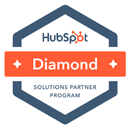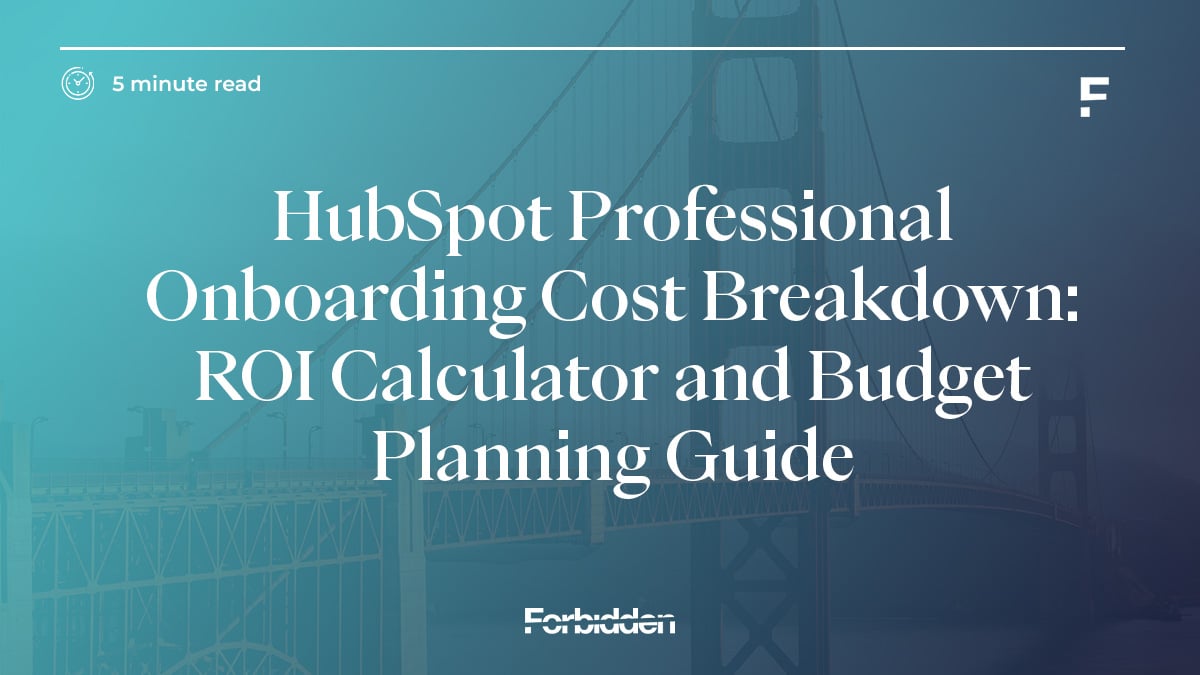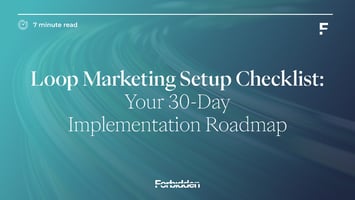HubSpot Professional Onboarding Cost Breakdown: ROI Calculator and Budget Planning Guide
Complete Cost Analysis
Understanding the full cost of HubSpot Professional onboarding is crucial for businesses aiming to maximise ROI and avoid unexpected expenses. Beyond the clear-cut subscription fees, a comprehensive evaluation must cover agency partner rates, internal resource allocation, and less-visible implementation expenses.
Agency charges; whether for strategic planning, technical execution, or post-launch optimisation, can significantly increase total spend. Simultaneously, internal time commitments for process mapping, data migration, and team training often represent a hidden cost that is frequently underestimated.
Additional unforeseen expenses, such as integrating legacy systems, customising automation workflows, or resolving data integrity issues, can rapidly expand the true project scope and inflate budgets. Proactive, transparent costing at the outset safeguards your investment strategy and enables informed decisions that support both immediate adoption and long-term business growth.
Official Onboarding Fees Breakdown
HubSpot offers structured onboarding packages for Professional accounts, generally priced depending on the number of contacts and included hubs. These fees typically range from £600–£3,000 per hub, covering setup guidance, training sessions, and initial configuration. While these fees cover the essentials, they don’t account for business-specific nuances, complex data migration, or advanced automation setup.
Agency Partner Rate Ranges
Hiring a certified HubSpot agency can accelerate onboarding and provide specialised expertise. Rates vary:
-
Small agencies: £100–£150/hour
-
Mid-tier agencies: £150–£250/hour
-
Enterprise-focused partners: £250–£400/hour
While more expensive, experienced agencies can prevent costly mistakes, optimise workflows for ROI, and reduce internal workload, particularly valuable when launching multiple hubs or complex automations.
Internal Resource Allocation
Internal costs often fly under the radar. Consider the hours your marketing, sales, and operations teams will dedicate to:
-
Data cleaning and import
-
Workflow and pipeline configuration
-
Training sessions and adoption support
Even at modest hourly rates, these costs can match or exceed external fees if not planned. Tracking internal effort upfront allows you to compare it to external agency time ensuring your budget aligns with your desired onboarding speed and quality.
Hidden Implementation Expenses
Common “hidden” costs include:
-
Custom integrations and API work
-
Migration of legacy data and historical records
-
Advanced reporting or dashboard configuration
-
Post-onboarding support and optimisation
Acknowledging these early avoids surprises and ensures ROI calculations reflect the true total cost of ownership.
Onboarding Approach Comparison
Businesses generally have three distinct pathways for HubSpot Professional onboarding, and each path strikes a different balance between investment, implementation speed, and level of support. These options; self-service onboarding, guided onboarding with HubSpot, and agency-managed implementation, offer varying degrees of control, expertise, and resource requirements.
Deciding which route aligns best with your organisation hinges on your internal capabilities, project complexity, and appetite for hands-on involvement versus delegated execution. Careful selection here not only determines upfront costs but also influences adoption velocity, operational risk, and your ability to unlock HubSpot’s full potential from day one.
Self-Service Onboarding Pros & Cons
Pros:
-
Lowest cost option
-
Full control over timelines and configurations
-
Good for simple setups
Cons:
-
Requires internal HubSpot expertise
-
Risk of misconfiguration or missed best practices
-
Slower adoption across teams
Self-service is best for small teams or straightforward setups, but larger organisations often find it costly in time and errors, which can reduce ROI.
HubSpot Guided Onboarding Value
HubSpot Guided Onboarding strikes a balance between DIY and agency support. Benefits include:
-
Structured step-by-step guidance
-
Access to HubSpot experts for Q&A
-
Training sessions for your team
While more expensive than self-service, it accelerates setup and ensures compliance with best practices, reducing long-term operational risk.
Agency-Managed Implementation
Hiring an agency transfers much of the burden externally. Benefits:
-
Expertise in multi-hub, complex setups
-
Optimised workflows and automations
-
Faster deployment with fewer mistakes
The trade-off is cost. Agency-managed implementations are premium, but when correctly scoped, they often deliver superior ROI by minimising errors, shortening adoption cycles, and optimising internal resources.
Hybrid Models
Some businesses combine internal effort with agency guidance. A hybrid approach might involve:
-
Agency-led initial configuration
-
Internal team managing ongoing operations and tweaks
-
Periodic agency check-ins for optimisation
This approach allows control and cost efficiency while ensuring best-practice setup and adoption support.
ROI Justification Framework
Onboarding is an investment, not a sunk cost, but proving that investment requires measurable metrics and projections. By quantifying time savings, automation efficiency, and revenue impact, businesses can confidently justify onboarding expenses to leadership. This section introduces tools and methods, including an interactive ROI calculator, that allow teams to forecast the financial and operational benefits of onboarding, turning budget discussions into strategic business decisions.
Interactive ROI Calculator Demo
Our ROI calculator estimates financial impact by factoring in:
-
Time saved on manual workflows
-
Reduction in errors and duplicate data
-
Faster lead-to-deal cycles
-
Automation-driven revenue uplift
By simulating different scenarios (self-service vs agency-led), you can visualise payback periods and justify the upfront investment to leadership.
Productivity Gains Measurement
Onboarding frees internal teams to focus on strategic tasks rather than configuration. Track productivity improvements by measuring:
-
Hours saved per workflow or campaign
-
Reduction in manual data entry errors
-
Speed of campaign deployment
Even modest efficiency gains can offset significant onboarding costs when scaled across departments.
Automation Savings Quantification
Automation is the true value lever. By enabling email workflows, lead nurturing sequences, and dynamic reporting, HubSpot can reduce manual effort by 30–50%, depending on the complexity of your setup. Quantifying these savings helps make a business case for agency involvement if speed or quality is a priority.
Revenue Impact Projections
Finally, consider the revenue impact of improved lead-to-deal conversion and retention. Enterprise HubSpot users often see:
-
Higher campaign engagement
-
Faster opportunity progression
-
Better alignment between marketing, sales, and service
Projecting even conservative revenue gains demonstrates how onboarding is not a sunk cost but a revenue-generating activity.
Budget Planning & Optimisation
Effective onboarding doesn’t just happen on its own; it requires strategic planning, phased budgeting, and resource alignment. Enterprises must balance cost, timeline, and internal capacity to get maximum value from their HubSpot investment. This section explores methods for allocating resources efficiently, planning phased rollouts, and optimising timelines so onboarding delivers measurable ROI while setting the foundation for long-term growth.
Phased Implementation Strategies
Break onboarding into phases, such as:
-
Core CRM setup and data migration
-
Hub-specific workflows and automation
-
Team training and adoption
Phasing spreads costs, allows early wins, and reduces internal strain, making ROI visible earlier in the process.
Cost-Effective Resource Allocation
Allocate internal resources strategically. Focus in-house effort on areas that require business context (lead scoring rules, reporting requirements), while outsourcing technical configuration and integration tasks to agencies or HubSpot Guided Onboarding.
Timeline vs. Budget Trade-offs
Speed costs money. A faster onboarding with agency support incurs higher upfront fees but reduces risk and adoption lag. A slower, self-managed rollout may save money upfront but can delay revenue realisation and reduce ROI. Understanding trade-offs helps executives make informed decisions.
Long-Term Investment Roadmap
Finally, treat onboarding as a foundation for future growth. Plan budgets for:
-
Ongoing optimisation and training
-
Incremental feature rollouts
-
Periodic audits of workflows and automations
This ensures HubSpot remains an investment, not a one-off expense, maximising ROI as the business scales.
Key Takeaways
Successfully onboarding HubSpot Professional isn’t just about completing setup tasks, it’s about turning investment into measurable business outcomes. With the right understanding of costs, approach, ROI, and budgeting strategies, teams can avoid hidden pitfalls and ensure the platform delivers maximum value from day one.
-
Full cost visibility is essential: account for official fees, agency rates, internal hours, and hidden expenses.
-
Onboarding approach matters: self-service, guided, agency-led, or hybrid all have trade-offs in cost, speed, and risk.
-
ROI can be measured and projected: leverage calculators, productivity metrics, and automation savings to justify investment.
-
Phased budgets and strategic resource allocation minimise risk and optimise adoption.
-
Long-term planning maximises value: HubSpot onboarding is an investment in scalable growth, not a one-off cost.
By applying these principles, businesses can confidently plan, execute, and scale their HubSpot Professional onboarding. The result is not just a functional CRM, but a strategic growth engine that aligns teams, optimises processes, and drives measurable revenue impact.











